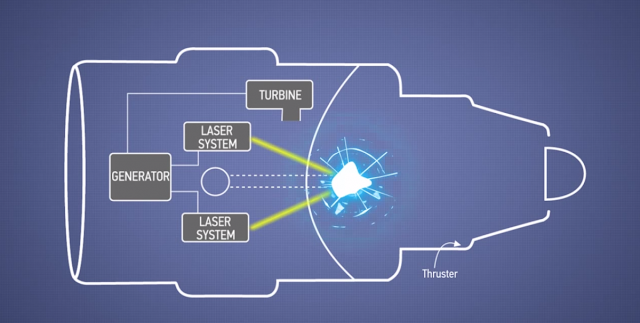Boeing Patents for Laser & Nuclear Driven Airplane Engine
Recently, the U.S. Patent and Trademark Office had approved an application from Robert Budica, James Herzberg and Frank Chandler from Boeing, for a laser and nuclear driven airplane engine.Future aircraft could now be powered by lasers and nuclear explosions if Boeing intends to have its way.
The technology would mean that the spaceships and planes would need only a fraction of power for operating as per the recent patent filed by the company. Airplane makers are continuously on the look-outin finding new and efficient options of powering their products and this laser engine seems to be the latest notion by the engineers at Boeing.
The idea patented was to make air travel an efficient one. Presently we have airplanes like the Solar Impulse 2 which uses only solar energy to travel across Pacific and intends going on a world tour. For a long time now, airlines have been attempting to come up with concepts to decrease carbon emissions and nuclear powered airplanes would be great innovation.
The engineers give some insight on how the nuclear powered tend to work. The radioactive material is vaporized by a targeted Laser on them, leading to a controlled Nuclear Fusion reaction with high energy neutrons discharging out.
Boeing Dreamliner Powered by Several Turbofan Engines
Besides the radioactive material, the engine requires very little with regards to external energy. The high energy matter is absorbed which then propels the aircraft forward.As all the nuclear reactions tend to go, it sustains itself.
The uranium 238 which is coated on the interior of the thruster’s wall undergoes nuclear splitting when struck by high energy neutrons that are generated by the earlier reaction. This tends to generate plenty of heat. Heat that is from the fusion chamber is cooled off and directed to a generator which powers the Laser.
All this seems quite convincing on paper though several queries with regards to controlling the nuclear reactions and its safety tend to come up.Modern airliners like the Boeing Dreamliner are powered by several turbofan engines which organize a series of fans as well as turbines to compress air and ignite fuel in order to provide push.
Power Rockets/Missiles/Spacecraft
The newly patented engine of Boeing provides push in a different and unique way and as per the patent filing, the laser engine could also be utilised in powering rockets, missiles as well a spacecraft. This is one of the ideas which the engineers have proposed to power an airplane. Bio-fuels too have been in testing for a long time.
According to United Airlines, flights which tend to run on fuel resulting from farm waste would soon begin from San Francisco and Los Angeles. These seem to be the main steps being adopted in helping to protect the environment. Up to now, the engine tends to live only in patent document and the technology is such that it is unclear if anyone would ever intend to build it.
It seems to be one of those patents which in no way indicate that the company that filed it intends working on what the patent is patenting. This is because Boeing does not seem to be actively developing a laser triggered fusion powered jet engine. Speculations are on whether the nuclear powered airplanes would become a reality or not.








